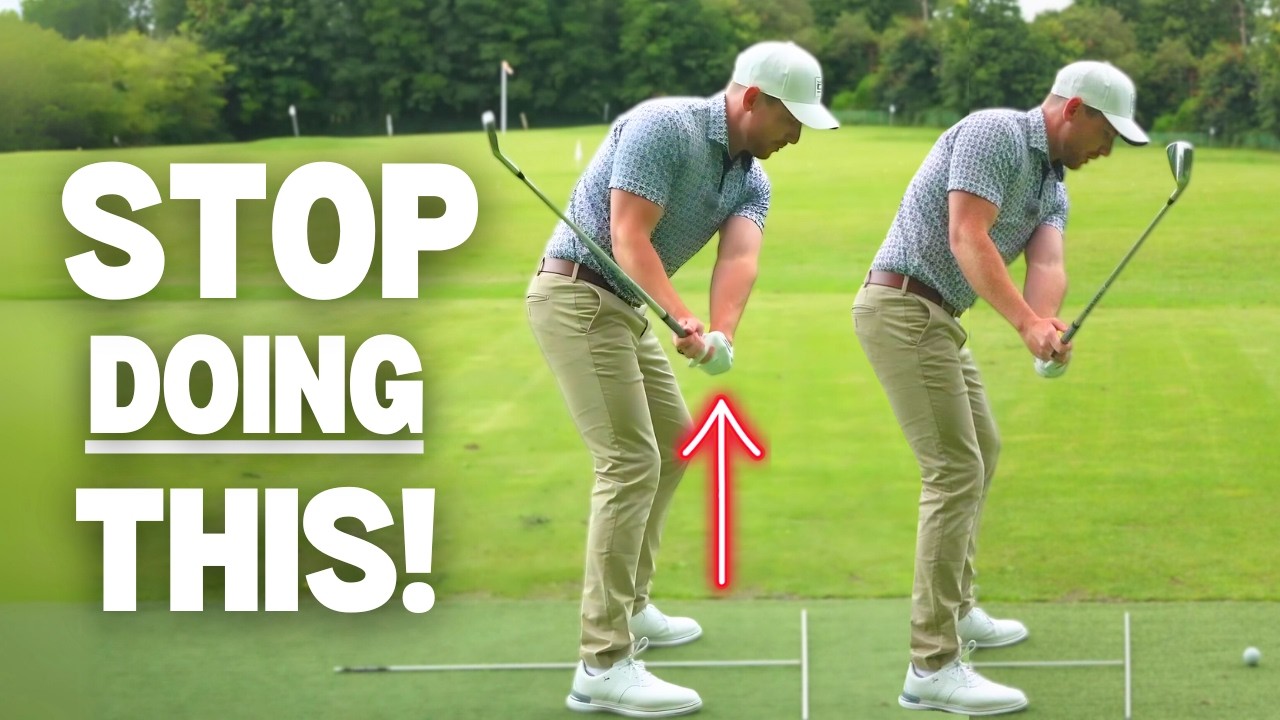If you’re battling a slice or struggling with inconsistent contact, do not try to shallow your swing in an attempt to fix it.
In this golf lesson, PGA Pro Kerrod Gray and Hugh Marr (@hughmarrcoaching) break down why shallowing the shaft can actually exaggerate your slice—and explain why fixing your face angle and impact position first is the key to hitting straighter, more solid shots.
Subscribe for Daily Golf Content! 🔔
SUPPORT THE CHANNEL
▀▀▀▀▀▀▀▀▀▀▀▀▀▀▀▀▀▀▀▀▀▀▀▀▀▀
My Best Selling EBOOK: https://bit.ly/3v9OL0m
Get a Private Lesson: https://www.perform.golf/offers/CkFnkbRi/checkout
Download My App: https://www.perform.golf/links
(Over 600 instruction videos for all skill levels)
TRAINING AID DISCOUNTS
▀▀▀▀▀▀▀▀▀▀▀▀▀▀▀▀▀▀▀▀▀▀▀▀▀▀
Visit my Pro Shop for coupon codes on 100’s of training aids and golf gear!
https://proshop.perform.golf/
SOCIAL MEDIA
▀▀▀▀▀▀▀▀▀▀▀▀▀▀▀▀▀▀▀▀▀▀▀▀▀▀
Website: https://kggolf.com
Instagram: https://www.instagram.com/kerrodgraygolf/
Facebook: https://www.facebook.com/kerrodgraygolf
TikTok: https://www.tiktok.com/@kerrodgraygolf/
Twitter: https://x.com/kerrodgraygolf
COACH KERROD
▀▀▀▀▀▀▀▀▀▀▀▀▀▀▀▀▀▀▀▀▀▀▀▀▀▀
Hi! I’m Kerrod, an award-winning PGA golf coach and Pro Golfer. Join me on a journey around the world as I collaborate with the brightest minds in the game to discover evidence-based strategies and tools that can help you improve your golf game.
CHAPTERS
▀▀▀▀▀▀▀▀▀▀▀▀▀▀▀▀▀▀▀▀▀▀▀▀▀▀
0:00 – Shallowing the Golf Club
0:50 – Clubface Position in the backswing
1:55 – Does Shallowing Fix a Slice
4:15 – Wrist Angles and Clubface Control
5:20 – How to Fix Your Low Point
5:55 – Best Way to Fix a Slice
7:55 – Ball Position To fix a Slice
#golflesson #golfswing #golftips #golfdrills #swingtips #golfinstruction #golfcoaching #golf #golfdrill
So, there’s a lot of golf advice out there that you hear thrown around with mates. And one of them is really what we could say is probably the worst bit of golfing advice out there. And pros use it as well. It’s all about shallowing, isn’t it? It’s all about shallowing the club. So, let’s start by debunking the myth that all good players shallow it. Yeah. Because it’s one of the challenges, I guess, with social media is that everything gets sold as an absolute. this is the thing that all the great players do, so you must do it. Complete nonsense. Yeah. The reality is that Mickelson was a stateer. If you look at John Ram, he’s a stateer. You look at Gary Woodland, he’s an extreme stateer. There’s a ton of players that have been ever ever so good and carry that characteristic. Uh the the challenge I think is the way that it’s sold to club players. Okay, so we’re dealing with a specific set of players here. Open face slicers the only kind of slicer. So let’s let’s frame that for the players at home. So an openf face slicer. So let’s say that be it my grip or wrist angles whatever throughout the swing by the time the club is down in this club shaft level position we’re going to see that the face would be open open so more than or toe up being as open as open as you’d like but you’ll see a lot of players getting the even the toe pointing behind them pancake flattening it ideally the reference point within reason is that we want that club face angle somewhat matching our spine angle so anything past that, let’s say extreme open. I tend to work with in corridors. Yeah. So, if I’m looking at a draw player, then I would want to see it more toe up. Mhm. And a fade player more towards spine angle. So, that’s basically the the vector that I’m working on when it comes to face angle at P6 at club parallel. Okay. So, uh we’re going to see the player who’s really going to have an extreme. Let’s say this guy. And then the club head moving in, let’s say, an out to in or from away and across. So this player, right, they watch a video and they go, “Let’s shallow it.” Yep. What benefit is going to happen with shallowing it? Okay. So we’ve already got the face pointed to the right. Yeah. And if we shallow it more, the face will point further to the right. Now there is a little caveat to this, but which we’ll come on to in a minute. So now you’ve taken a slicer and made it into a really big slicer. Yeah. The other challenge is that the more you shallow it, the more the low point will move back. Yes. Yeah. So generally when we’re looking at club players, probably the single most common thing I deal with with club players is not hitting the ground far enough in front of the golf ball or not hitting the ground at all. Totally agree. So if they’re already hitting it behind the ball, then shallowing it is only going to hit even further behind the ball. Yeah. So a marginal flat fat shot becomes a debilitating fat shot. Let’s quickly demonstrate that. So let’s say the player is very very open. They’re swinging uh across it from a high to a low position. We can see how that cutting across would almost counteract and they would be able to at least get the bottom of the swing forward. Correct. But if I from that position and in reference to shallowing shaft, let’s just say that the shaft is tipping in this direction. As I get to that down swing and I go, well, I don’t want to slice it anymore. And I have heard that I want to shallow the shaft. If I then start doing this, I’m not even going to try and hit this ball for you because I’m going to hit you. We can see that not only is now the club getting closer to the ground earlier. Yep. But it’s also going to be in such a position where the face is going to be wide open. Correct. And remember, we’re talking about a very specific set of players here. Yeah. That if the face is pointed, let’s say the face is 10° to the right. Mhm. The player does is is fully aware that he needs to put something in there to try and square that up. And that something is generally swinging the club more than 10° to the left. Yeah. Yeah. So, if we suddenly just shallowed it out to shift the direction of the swing, that face is now pointed even further, right? Yeah. We’re in some trouble. Now, one of the one of the points, someone made an interesting point when I posted about this recently. What about getting players to shallow it Mhm. through changing wrist angles? Mhm. Now, yes, again, the change of the wrist angle here, so going from the cuped position to a maybe even slightly bowed position, that would definitely strengthen the face. Yeah. But it wouldn’t tidy up the fact that the player’s hitting behind the ball. Correct. Correct. So yes, the face may be in a better position, but the low point relative to golf ball is still dysfunctional. Too far behind. Correct. And at the end of the day, the three main fundamentals of golf are impact, speed, and control. Impact without a doubt is the most important cuz it’s really going to dictate our speed and distance. And also our ability to get the ball started on our intended line and the height and curvature of it. So impact get the ball first, ground second contact is what we’re looking for here. Correct. Also, and this is something that’s just become I guess it’s become a talking point in the industry that lowoint isn’t just its location relative to the golf ball and the target line. Sure. It’s its relation to the target line in and out and also the depth of it. Yeah. Yeah. Yeah. So if you combine those three, you talk about impact. If you com combine appropriate depth, position, and horizontal position of the low point, you will hit the middle of the club. Yeah. Yeah. Perfect. So for what we’re talking about here is the player who is struggling this their first point of contact with the ground regardless of those is behind. So we need to ensure that it is always on the target side that first point of contact there. Correct. So if the ball is on the ground correct? Yeah. So let’s say the player is in this position face open. They’re swinging from a high to a low orientation to try and uh naturally counteract the open face. And then they’re out there and they’re trying to shallow it. They’re going to see the bottom of the swing get further behind. Correct. The fat even more and the face will be even more pointing out. Correct. Great. So, what do they do to rectify this? Never say that. I’ll never say that this is an absolute but generally my process with slicers is pretty much the same. Okay. So, ball curves to the right. What does that mean? It means that the face is open to the path. M and the larger that vector, the more the face is to the right of the path for a right-handed player, the more the ball moves to the right. That simple. So my first job is to bring the face closer to the path. Cuz if all I do is shift the path, then the vector is even further right as you’ve talked about. So all I do, I will start by bringing that closer to the path. Mhm. Beauty of that is that they already will hit better golf shots like that. Yeah. They may be poles, but they’ll be more functional. They’ll feel better. They might even have a draw. Might be in the left bush, but better. They’ll go faster. They’ll carry further. I mean, and you won’t have to change the speed you swing it. Yeah. So, I’ll do that first and then shift the pattern. Let’s just quickly show players what happens when we do that. So, I’m going to make exactly the same down swing. The first one I will match an open club face with an out to-in swing. And let’s look at the flight on this. So, it started straight bit of curvature. And we might go at that speed, it went straight. Soon as we get a driver, it will not. N. If I then just simply get the club face in a stronger position. And I’m just going to do that by a simple grip change over here. But I’m still going to swing out to in. Same speed. Now we get a beautiful draw. Yes. Completely in the wrong direction. But tell you what, felt much better. Way closer to a proper golf shot. Yeah. Straight away. That’s where most people quit though, isn’t it? Yes. They go, “Oh, it went left. That’s bad.” What are they missing? And that’s where I mean, from a coaching perspective, I’m always trying to paint the pathway for them. Say, “Let’s get this to this place, and then I can move this to this place.” What’s going to happen here is you’re going to hit it left. I’m going to shift your path. You’re now going to hit it online. So, what’s gone from being a big smelly ugly cut? Yeah. Now becomes a little push draw. Now, that might happen. It might happen in one session. Might take 6 months. Yeah. Yeah. But bear in mind, as soon as you’ve got that face vector, and I think it’s the same for hook shots as well, first job is to get the face closer to the path. Yeah. Not shift the path. So, my preference, we happened to do that on the first shot. got lucky. How do we then hit a reasonably straight golf shot from there? How long’s a piece of string? Where’s it come from? So, generally, if you’re looking at this this openf face player, the characteristic they present with is they put the ball further and further forwards to buy them time to get the face back to square. Mhm. So, once that pull shot has been introduced Mhm. let’s roll the ball back a little bit. Love it. So, back of the ball under the sternum would be a decent reference point. So, let’s for exaggeration purposes here, uh, over a period of time of that play with the open face and cutting out to in, they’re going to have the ball way too far forward, which then just allows them time to meet the ball. So, if I hit that shot from that position with the closed face, it’s going to go way left. And because the golf club arcs around our body, the further back you move the golf ball, uh, relative to your stance, for simplicity purposes, uh, it’s going to meet the ball earlier in its down swing arc. So therefore, the path is going to be more out to the right. I’ll set up and then move the ball. I’m going to feel like even further back just for the sake of it from here, making sure I’ve got my same face. And what I’ll do is I’ll make a very similar swing to what I did before. And let’s just see if it goes straight up. Okay. and started just left the target with now a little draw. Sure, the contact felt quite uh deep with the arc height. So, the club went a long way in the ground. We’re going to see that as a natural reaction because the player was coming in. Yeah. So really what we’re saying here is the crux of it is the player heard some information around trying to shallow their golf swing but at the end of the day it was really nothing to do with shallowing the golf swing which fixed the slice off the face and that’s why spending time with a really good coach will help you. You can’t self diagnose. Golfers are notoriously bad at self diagnosing. Yeah. You wouldn’t go to a doctor and tell them what was wrong with you. Yeah. Yeah. Yeah. You just wait for him to tell you what to do. Yeah, it’s exactly the same here. Identify the cause, get to work on the cause. Yeah, this is dealing with effect. Love it. So, if you’re looking at your swing and in the down swing, it’s steep. Don’t be quickly to judge and think you need to shallow it. Remember, face is king. Let’s look at that first before we start changing the look of your swing. Thanks for watching this video. YouTube thinks that you would benefit from watching this one next. So, click that card and it could be the tip that you need to take your game to the next level. I’ll see you next time.








7 Comments
If you enjoyed the video please subscribe! 🔔
If you fix path, face angle is an easy fix. Most slicers open the face due to horrible path so they don’t hit dead left. Moving the ball back to accommodate bad path, bad philosophy
Ernie Els
One club path back same on the way back on the same plane
Keep it simple
John Daly always been a casual swing with no maths involved
There is just so much on YouTube it’s not funny
Great info!
Your so right, I would love to see someone copy Jim Furyk's swing 😂🤨🇺🇲
This particular aspect of the swing is never explained well on all of YT but it is critical. People swing left to get the low point forward. Contact becomes an issue when trying to fix OTT. Therefore the key is how to get divot forward when swinging from inside…. thanks for this, get the ball back will help. Please expand on this more… i have been teying to shift laterally more to get divot forward but i feel weird over the ball in DS bc ive shifted and perspective is off… so yes please more on this subject. Thanks
Great video, where is this golf coach based 😂 or are you the coach also.